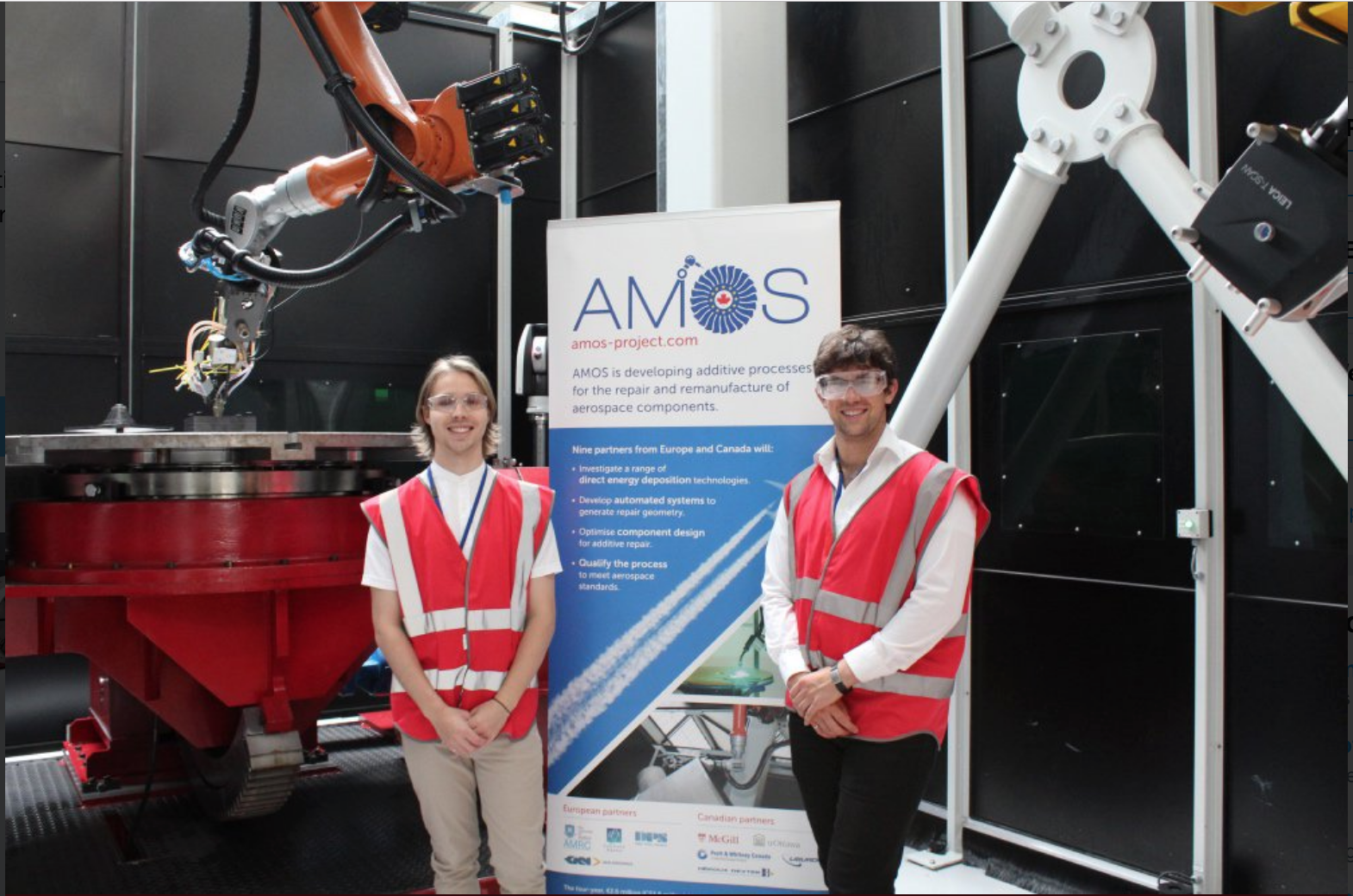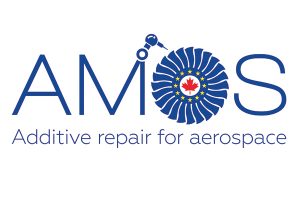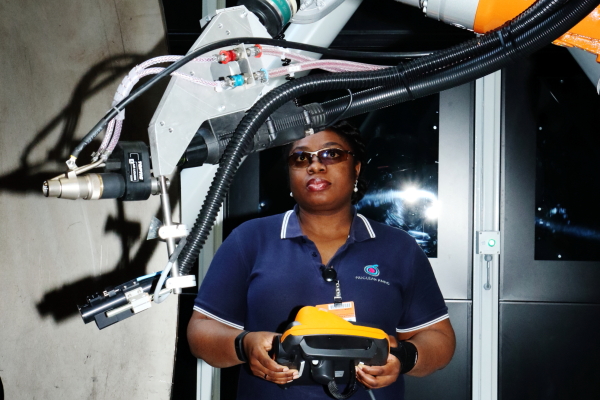Additive Flight Solutions gains AS9100D certification for its 3D printed aerospace parts
GKN Aerospace to Open Latest Additive Industries Process and Application Centre Close to Bristol, UK
GKN Aerospace is just one aspect of the powerhouse of manufacturing activity emanating from GKN—a company rich in history—with origins founded as far back as the 1700s. Overall, GKN presents a huge emphasis on 3D printing and additive manufacturing processes that only continues to grow within all of their main divisions featuring aerospace, automotive, powder metallurgy, and wheels and structures. With main headquarters in the UK, GKN Aerospace continues the overall forward momentum as CTO Russ Dunn opens the latest Additive Industries Process and Application Centre close to Bristol.
![]() So far, other Additive Industries centres have been opened in Eindhoven, Los Angeles, and Singapore. Each facility offers its ‘own specialism’ related to AM processes. The UK & Ireland Process and Application Centre is situated at Filton Aerospace Park, famously known as the site of the Concorde’s development and production in the 60s and 70s. Other important aerospace activities are currently taking place there, as well as engineering and manufacturing, with industry leaders like Airbus, Rolls-Royce, and GKN working nearby.
So far, other Additive Industries centres have been opened in Eindhoven, Los Angeles, and Singapore. Each facility offers its ‘own specialism’ related to AM processes. The UK & Ireland Process and Application Centre is situated at Filton Aerospace Park, famously known as the site of the Concorde’s development and production in the 60s and 70s. Other important aerospace activities are currently taking place there, as well as engineering and manufacturing, with industry leaders like Airbus, Rolls-Royce, and GKN working nearby.
 The site, now completely renovated and ‘in line with all the highest standards,’ has been used for numerous aerospace projects in the past, as well as lightning strike tests. The Additive Industries facility at this site will allow for a focus on both the production of new materials as well as continued process development.
The site, now completely renovated and ‘in line with all the highest standards,’ has been used for numerous aerospace projects in the past, as well as lightning strike tests. The Additive Industries facility at this site will allow for a focus on both the production of new materials as well as continued process development.
On March 12th, Russ Dunn, CTO of GKN Aerospace, Dr Mark Beard, Additive Industries’ Global Director Process & Application Development and General Manager of the Centre, and Daan Kersten, CEO of Additive Industries, will oversee the official opening ceremony of the facility.
The opening ceremony and event will run from 11:00 am to 5:00 pm. There will be a full schedule, featuring presentations and announcements. During the afternoon, those attending can expect the following:
- Presentation about GKN Global Technology Center (also in Filton) – by Paul Perera, VP Technology at GKN Aerospace.
- Discussion on the additive manufacturing vision for Airbus, and perspective on the growing AM ‘ecosystem’ in Filton – by Dave Best, Head of Business and Strategy for Airbus.
- Presentation on APWorks and their choices for advancing in industrialization, working with the Additive Industries Competence Centre in Filton; accompanied by a case study that includes GKN and ANSYS – by Jon Meyer, CPO for APWorks.
Both GKN and Additive Industries continue to be a powerful—and advancing—presence within the AM field, around the world. GKN has collaborated with other companies like GE Additive and Porsche, and recently they purchased Forecast3D. Additive Industries has also been in the 3D printing news headlines as they partnered with APWorks, Volkswagen, the Switzerland-based Sauber F1 Team, and more.
What do you think of this news? Let us know your thoughts! Join the discussion of this and other 3D printing topics at 3DPrintBoard.com.
[Source / Images: Additive Industries]
The post GKN Aerospace to Open Latest Additive Industries Process and Application Centre Close to Bristol, UK appeared first on 3DPrint.com | The Voice of 3D Printing / Additive Manufacturing.
GKN Aerospace’s £33 million AIRLIFT and DAM programs aim to accelerate industrial additive manufacturing
GKN Aerospace commissions Cell 2 additive manufacturing production cell at ORNL
A visit to HP’s new 3D Printing and Digital Manufacturing Center of Excellence, Barcelona
University of Sheffield joins €17 million INTEGRADDE project to accelerate industrial additive manufacturing
AMOS project presents DED findings at opening of UK Nuclear Advanced Manufacturing Research Centre
The AMOS Project is Investigating Repair and Maintenance Technologies for the Aerospace Industry
There has been enormous progress in terms of aircraft safety in the past two decades. However, last year, the Aviation Safety Network recorded a total of 15 fatal airliner accidents, resulting in 556 deaths. With an estimated worldwide air traffic of about 37,800,000 flights per year and over three million passengers flying on any given day, an aviation industry objective is to keep their aircraft from potential failures with faster on-demand repairs and lower costs. For the last few years, we have seen how 3D printing techniques have been well received in the aerospace industry; the technology is transforming prototyping, the manufacture and maintenance of end-use parts, as well as the production of custom pieces; even the FAA has been developing a comprehensive regulatory plan to deal with aerospace’s industry adoption of 3D printing technology. One international research project in particular has been carrying out an investigation to help the industry understand the pros and cons of how additive manufacturing technology can help with the repair of aircraft parts. Led by the University of Sheffield’s Nuclear Advanced Manufacturing Research Centre (AMRC), the Additive Manufacturing Optimisation and Simulation (AMOS) project focuses on additive technologies already being used in the aerospace industry. It also addresses the potential of different direct energy deposition (DED) methods, like a range of techniques which combine conventional welding tools with automated control to accurately deposit and melt metal powder or wire, or the wire-feed gas tungsten arc process used by Nuclear AMRC’s bulk additive cell. The project’s team is trying to see how these techniques can reduce the time and cost of regular maintenance and repair for aircrafts, while decreasing material waste and extending the life of expensive components.
According to Yaoyao Fiona Zhao, a professor at McGill University’s Additive Design and Manufacturing Lab, “the project will provide a fundamental understanding of thermal and mechanical behaviour of powder and wire material during deposition, and also a simulation and optimisation platform for industrial partners to further develop their component-specific applications”.

McGill students study additive cell at Nuclear AMRC to feed into defect detection and process planning work
AMOS is a limited time project that began its research on February of 2016 and has an end-date on January, 2020. With over 2.9 million dollars invested, it is one of the first European-Canadian projects to be funded under the ‘Mobility For Growth’ collaboration in aeronautics R&D. The project focuses on several key Direct Energy Deposition AM processes that have great potential to be used as cost-effective and efficient repairing and re-manufacturing processes for aerospace components, such as turbine blades and landing gears. If successful, eventually the project will aid in reducing the weakness of aerospace components at the design stage and extend their life cycles.
“There’s a host of additive manufacturing technologies available to aerospace manufacturers, but they tend to be focused on new production rather than repairing damaged parts; and the AMOS project is bringing together some of the world’s leading research organisations and companies to identify which additive technologies are best suited for repair and remanufacture, and develop them for commercial use,” explained Rosemary Gault, the European project coordinator at the University of Sheffield AMRC.
The AMOS consortium includes nine partners from Canada, France, Sweden and the UK, including research organisations, top-tier aerospace manufacturers, and specialist technology developers. École Central de Nantes in France; GKN Aerospace Engine Systems, McGill University of Montreal and jet engine manufacturer Pratt & Whitney are some of the partners. It is supported by the European Commission through the Horizon 2020 programme and by Canadian funding agencies CARIC and NSERC.
The project will involve a range of additive manufacturing technologies used at the participating centres and companies, including laser powder and robotic laser wire systems operated by Liburdi in Canada, a CNC laser powder facility at Ecole Centrale de Nantes in France, and robotic powder diode laser and wire-feed gas tungsten arc facilities at the University of Sheffield AMRC. At McGill University, AMOS is employing an additive machine which will be used to deposit Titanium. No surprise there, the use of Titanium has grown driven by needs in the aerospace industry, and according to a report by SmarTech, shipments of titanium powders grew by 32% in 2018, with the report predicting a 24% growth in titanium alloy revenues in 2019. As the metal AM market grows, so does the demand for metal powders. Material research will focus on three widely used aerospace alloys: Titanium 6-4 alloy (in wire and powder form), AerMet 100 highstrength stainless steel powder and the nickel-chromium superalloy Inconel 718.
According to AMOS, results for Inconel proved that wire-deposited materials showed better tensile properties than the powder-deposited material, for both the as-built material and the interface region. For titanium wire, yield stress, ultimate tensile strength and elongation are comparable with the standard reference material. However, when using powder, the results were below those of the reference standard. The investigation into Aermet 100 is ongoing but the majority of the tests have been completed, although work is also continuing on low-cycle fatigue and crack propagation.
The Nuclear AMRC’s research for Amos has generated huge amounts of metallurgical data for quantifying the variations between conventional, as-built and repaired materials, while investigating the interface integrity, performance and predictability of the alloy materials in different orientations, and how this data can facilitate the development of DED repair standards. The Nuclear AMRC team is now working with samples featuring a series of intentional defects, produced by GKN Aerospace. The samples have been scanned using an innovative inspection process developed by Canadian partners Liburdi and McGill University, and the Nuclear AMRC’s non-destructive testing specialists are benchmarking the new technique against current practice. Looking into automated processes for detecting defects to facilitate DED repairs. According to the specialists, they can now identify certain types of defects such as voids and tool marks relatively easily, while cracks are more challenging.
Aerospace manufacturing companies are trying to make their aircraft fully sustainable and 3D printing technology is helping with that by making parts lighter, which in turn saves the companies money from less fuel consumption, emissions, and increased speed. Most commercial aircraft makers are racing towards additive manufacturing technology to cut costs in repair and maintenance as well. Aircraft maintenance companies are under a lot of financial pressure from carriers, who demand these low cost repairs using high quality processes and spare parts. Other projects, like RepAir, are also tackling this issue with additive manufacturing, engaging in research on future repair and maintenance for the aerospace industry and proving that the technology adds new opportunities for onsite maintenance and repair. With 3D printing taking center stage in aircraft repair and maintenance, as well as becoming the protagonist in many projects worldwide, perhaps we can expect better built structures, higher safety features on planes and even fewer fatal airliner accidents thanks to maintenance efforts on site.
GKN Aerospace Opens New Center of Excellence to Focus on Industry 4.0 Technologies
Today, GKN Aerospace announced that it is opening a new Global Technology Center in the United Kingdom. The center is being funded by a £17m commitment from GKN Aerospace and a £15m commitment from the UK Government, through the Aerospace Technology Institute. It is expected to open in 2020 and will be 10,000 square meters, housing 300 engineers. The center will also include collaborative space for research and development with universities, the UK’s CATAPULT network and GKN Aerospace’s UK supply chain.
“GKN Aerospace can trace its engineering heritage back to the 18th century and we are proud of our role as a leading player in the UK’s world leading aerospace sector,” said Hans Büthker, Chief Executive of GKN Aerospace. “The GTC will ensure we continue to develop new technologies that deliver for our customers, making aircraft more sustainable and economical. It will also support our 4,000 strong workforce in the UK, ensuring they remain at the cutting edge of the global aerospace industry. The GTC is a great example of the UK’s industrial strategy at its best: with industry and the Government coming together to invest in the technology of the future. The GTC will continue to foster such collaboration across the entire UK Aerospace ecosystem and we look forward to working with the British Government in the years to come.”
The new center will focus on additive manufacturing, advanced composites, assembly and Industry 4.0 processes in order to enable the high rate production of aircraft structures. It will also serve as the base for GKN Aerospace’s technology partnership in Airbus’ “Wing of Tomorrow” technology program, as well as new additive manufacturing programs.
GKN Aerospace has several Centers of Technical Excellence around the world. Each one has its own specific technology focus, such as additive manufacturing, thermoplastics and smart aero-engine systems. The centers are all supported and linked by a clear digital strategy.
“GKN Aerospace’s new Global Technology Centre further strengthens our aerospace heritage and engineering expertise, and will keep the UK at the forefront of the latest technologies and manufacturing processes for the next-generation of aircraft,” said Greg Clark, Secretary of State for Business, Energy and Industrial Strategy. “As the sector moves towards a cleaner, greener and more efficient future, we are partnering with industry through our modern Industrial Strategy and new Aerospace Sector Deal to ensure we have the skills, innovation and supply-chain to continue our world leadership in aviation.”
![]() Along with GKN Aerospace and the Aerospace Technology Institute, collaboration partners at the new Global Technology Center include the Advanced Manufacturing Research Centre (AMRC), Additive Industries B.V., ANSYS UK Limited, ATS Applied Tech Systems Limited, Centre for Modelling & Simulation, Digital Catapult, KUKA Industries UK Limited, Manufacturing Technology Centre, Materialise UK Limited, National Composites Centre, PXL Realm, Thales UK Limited, University of Bath, University of Bristol and University of Sheffield.
Along with GKN Aerospace and the Aerospace Technology Institute, collaboration partners at the new Global Technology Center include the Advanced Manufacturing Research Centre (AMRC), Additive Industries B.V., ANSYS UK Limited, ATS Applied Tech Systems Limited, Centre for Modelling & Simulation, Digital Catapult, KUKA Industries UK Limited, Manufacturing Technology Centre, Materialise UK Limited, National Composites Centre, PXL Realm, Thales UK Limited, University of Bath, University of Bristol and University of Sheffield.
Discuss this and other 3D printing topics at 3DPrintBoard.com or share your thoughts below.






